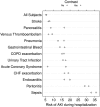Estimating the Risk of Radiocontrast-Associated Nephropathy
- PMID: 27688297
- PMCID: PMC5280012
- DOI: 10.1681/ASN.2016010021
Estimating the Risk of Radiocontrast-Associated Nephropathy
Abstract
Estimates of the incidence of radiocontrast-associated nephropathy vary widely and suffer from misclassification of the cause of AKI and confounding. Using the Nationwide Inpatient Sample, we created multiple estimates of the risk of radiocontrast-associated nephropathy among adult patients hospitalized in the United States in 2009. First, we stratified patients according to the presence or absence of 12 relatively common diagnoses associated with AKI and evaluated the rate of AKI between strata. Next, we created a logistic regression model, controlling for comorbidity and acuity of illness, to estimate the risk of AKI associated with radiocontrast administration within each stratum. Finally, we performed an analysis stratified by the degree of preexisting comorbidity. In general, patients who received radiocontrast did not develop AKI at a clinically significant higher rate. Adjusted only for the complex survey design, patients to whom radiocontrast was and was not administered developed AKI at rates of 5.5% and 5.6%, respectively. After controlling for comorbidity and acuity of illness, radiocontrast administration associated with an odds ratio for AKI of 0.93 (95% confidence interval, 0.88 to 0.97). In conclusion, the risk of radiocontrast-associated nephropathy may be overstated in the literature and overestimated by clinicians. More accurate AKI risk estimates may improve clinical decision-making when attempting to balance the potential benefits of radiocontrast-enhanced imaging and the risk of AKI.
Keywords: acute renal failure; nephrotoxicity; outcomes.
Copyright © 2017 by the American Society of Nephrology.
Figures



Comment in
-
Changing Paradigms in Contrast Nephropathy.J Am Soc Nephrol. 2017 Feb;28(2):397-399. doi: 10.1681/ASN.2016121369. Epub 2017 Jan 19. J Am Soc Nephrol. 2017. PMID: 28104823 Free PMC article. No abstract available.
References
-
- Nash K, Hafeez A, Hou S: Hospital-acquired renal insufficiency. Am J Kidney Dis 39: 930–936, 2002 - PubMed
-
- Josephson SA, Dillon WP, Smith WS: Incidence of contrast nephropathy from cerebral CT angiography and CT perfusion imaging. Neurology 64: 1805–1806, 2005 - PubMed
-
- Asif A, Cherla G, Merrill D, Cipleu CD, Tawakol JB, Epstein DL, Lenz O: Venous mapping using venography and the risk of radiocontrast-induced nephropathy. Semin Dial 18: 239–242, 2005 - PubMed
-
- Ng CS, Shaw AD, Bell CS, Samuels JA: Effect of IV contrast medium on renal function in oncologic patients undergoing CT in ICU. AJR Am J Roentgenol 195: 414–422, 2010 - PubMed
-
- Pahade JK, LeBedis CA, Raptopoulos VD, Avigan DE, Yam CS, Kruskal JB, Pedrosa I: Incidence of contrast-induced nephropathy in patients with multiple myeloma undergoing contrast-enhanced CT. AJR Am J Roentgenol 196: 1094–1101, 2011 - PubMed
MeSH terms
Substances
LinkOut - more resources
Full Text Sources
Other Literature Sources

